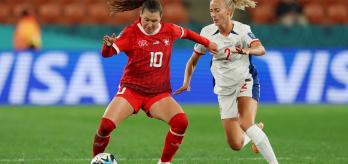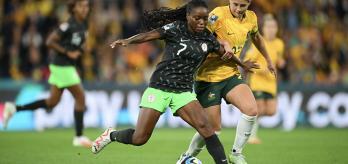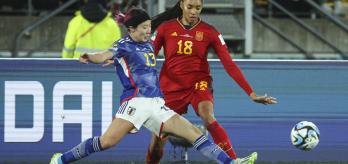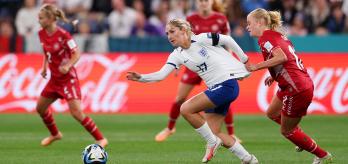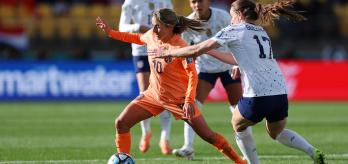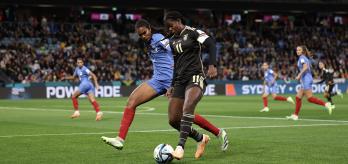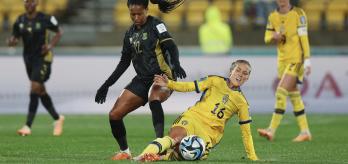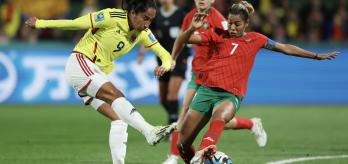Australia overcame a shock defeat to Nigeria to finish first by putting four past Canada in their final group-stage match. A tactically and physically impressive Nigeria side took one win and two draws to see them progress to the knockout stages in second place. Moments to remember included Australia kicking off their country's hosting of the tournament with a victory over the Republic of Ireland and Katie McCabe's goal from a corner kick against Canada, which will go down in the history books as the Republic of Ireland's first ever goal at a FIFA Women's World Cup.
Australia
Belinda Wilson: Australia's playing style is characterised by an assertive and proactive approach. Their defensive tactics revolve around a compact mid-block, with their forward and midfield lines effectively pressing opponents by employing a mix of direct and indirect pressure, channelling the ball into wide areas. This defensive tactic allows them to set traps and disrupt the opposition's attacking patterns in wide areas.
In the attacking phase, the Matildas rely on their central midfielders, Kyra Cooney-Cross (23) and Katrina Gorry (19), to trigger attacks that spread from the central corridor to the wide channels. This enables their full-backs and wide forwards to progress the ball into the final third to deliver crosses into the box, or exploit spaces with 1v1s and penetrate the penalty area.
Australia capitalises on their strong defensive tactic to regain possession and then skilfully exploit spaces in the wide areas. Their direct possession play and use of width allow them to create numerous goal-scoring opportunities.
Nigeria
Clementine Touré: Nigeria prefer to play a direct football and are happy to leave the possession of the ball to the opposition. Once play progresses past the halfway line, Nigeria look to play fast in behind the back of the opposition's defensive line.
Full-backs Ashleigh Plumptre (2) and Michelle Alozie (22) would run into the final third to create excess numbers and progress play on the wings. Here Nigeria would execute technical combinations and deliver crosses into the box, which would bring out the best of the technical and physical qualities of its attacking players Asisat Oshoala (8), Uchenna Kanu (12) and Rasheedat Ajibade (15). These players also thrived in 1v1 situations.
In their very organised and compact mid-block, midfielders Halimatu Ayinde (18) and Antoinette Payne (7) played a crucial role in recovering the ball and triggering counter-presses, which was one of the main strengths of the Super Falcons.
In the group stage Nigeria proved to be powerful, quick and tough, and they are able to play to their physical strengths, making them a tough opponent for anyone at this level. Their style of play allows them to compete and win.
Canada
Gemma Grainger: Canada started the tournament with a dominant display against Nigeria, with a clear style of play in possession featuring central rotations. This could be seen in all three games.
In this group, Canada dominated possession over their opposition. However, with only two shots on target against Nigeria, and three shots on target versus Australia, they failed to be effective in the final phase and capitalise on their possession.
Their final group game saw Australia needing to win the game to progress. Canada were overpowered by a strong Australian attacking performance from counter-attacks and attacks through wide areas. A lack of quality in the final phase meant Canada never really created any momentum in this tournament, leading to an exit at the group stage for the current Olympic gold medallists.
Republic of Ireland
Anja Mittag: This was Ireland's first appearance at a Women's World Cup. Their 5-4-1 out of possession stood out in particular. In this defensive structure they were very organised, disciplined, and compact in a low or mid-block. Ireland would look to force the opponent out to their wide channels and close the central areas of the pitch with an aggressive press. They consciously tried to exhaust their opponents.
In possession, they started moves with long goal kicks and would try to win the second ball and switch play to the wings if possible. If they turned over possession, they went into offensive transitions where they looked to play long balls into their forward, Kyra Carusa (18), who effectively created space and demonstrated physical prowess.
Katie McCabe (11) put in incredible performances for her team and scored their first goal ever at a World Cup. Her winning mentality helped create the Republic of Ireland's best chances. Besides that, her defense work, recovery, and progression play were all excellent.








